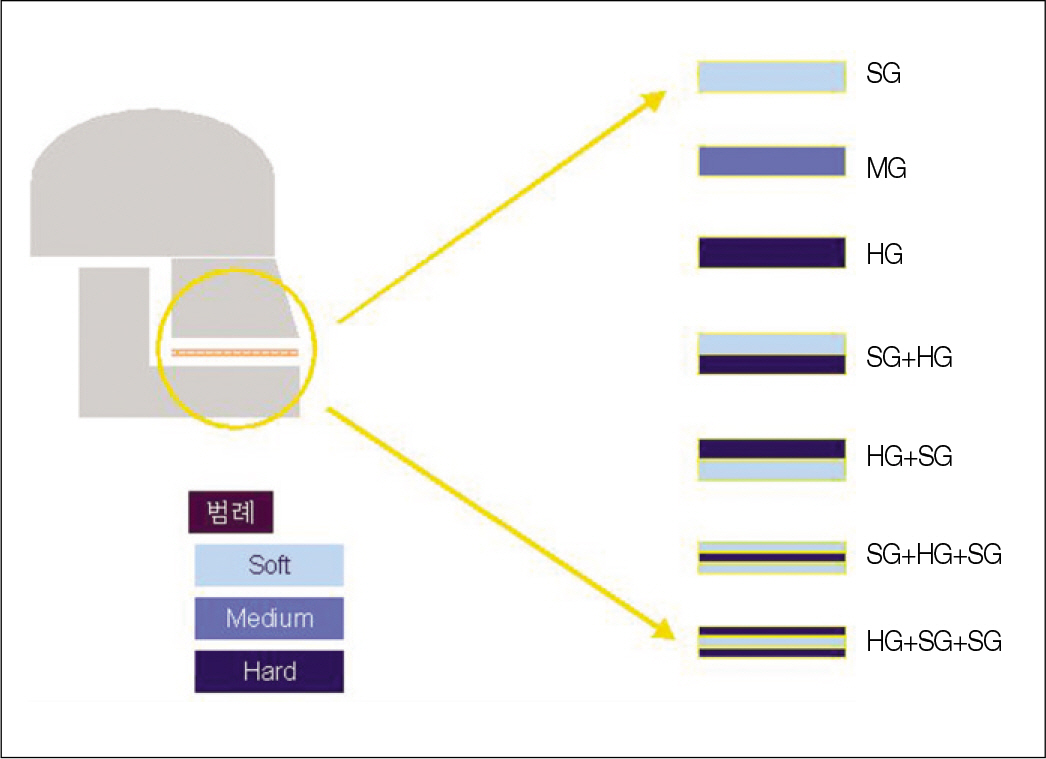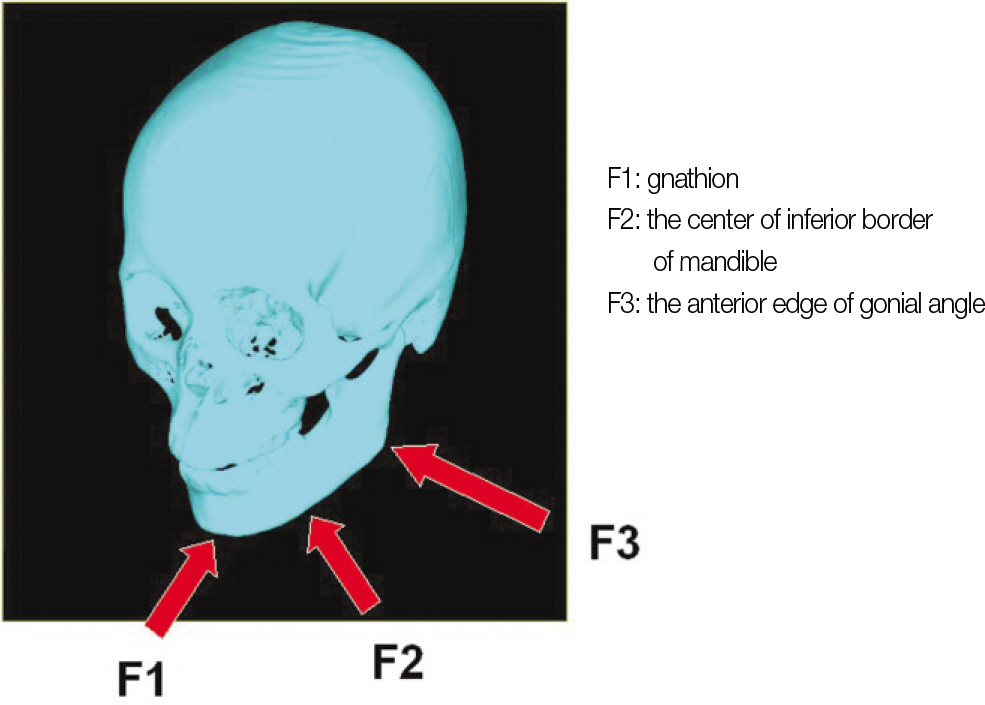J Korean Acad Prosthodont.
2011 Oct;49(4):324-332. 10.4047/jkap.2011.49.4.324.
Finite element analysis of the effects of mouthguard produced by combination of layers of different materials on teeth and jaw
- Affiliations
-
- 1Department of Prosthodontics, School of Dentistry, Kyung Hee University, Seoul, Korea. choi@khu.ac.kr
- KMID: 2195527
- DOI: http://doi.org/10.4047/jkap.2011.49.4.324
Abstract
- PURPOSE
The purpose of this study was to compare the stress distribution of teeth and jaw on load by differentiating property of materials according to each layer of widely used mouthguard.
MATERIALS AND METHODS
A Korean adult having normal cranium and mandible was selected to examine. A customized mouthguard was constructed by use of DRUFOMAT plate and DRUFOMAT-TE/-SQ of Dreve Co. according to Signature Mouthguard system. The cranium was scanned by means of computed tomography with 1mm interval. It was modeled with CANTIBio BIONIX/Body Builder program and simulated and interpreted using Alter HyperMesh program. The mouthguard was classified as follows according to the layers. (1) soft guard (Bioplast)(SG) (2) hard guard (Duran)(HG) (3) medium guard (Drufomat)(MG) (4) soft layer + hard layer (SG + HG) (5) hard layer + soft layer (HG + SG) (6) soft layer + hard layer + soft layer (SG + HG + SG) (7) hard layer + soft layer + hard layer (HG + SG + HG) The impact locations on mandible were gnathion, the center of inferior border, and the anterior edge of gonial angle. And the impact directions were oblique (45degrees). The impact load was 800 N for 0.1 sec. The stress distribution was measured at maxillary teeth, TMJ and maxilla. The statistics were conducted using Repeated ANOVA and in case of difference, Duncan test was used as post analysis.
RESULTS
In teeth and maxilla, the mouthguard contacting soft layer of mandibular teeth presented lowest stress measure and, in contrast, in condyle, the mouthguard contacting hard layer of mandibular teeth presented lowest stress measure.
CONCLUSION
For all impact directions, soft layer + hard layer + soft layer, the mouthguard with three layers which the hard layer is sandwiched between two soft layers, showed relatively even distribution of stress in impact.
Keyword
Figure
Reference
-
1.Taniguchi H., Ueno T., Sasaki Y., Sumita Y., Yamanaka T., Ohyama T., Wang K. Influence of MORA on isometric muscle strength of upper appendage during shoulder adduction. J Sports Dent. 1998. 1:31–9.2.Woodmansey KF. Athletic mouth guards prevent orofacial injuries. J Am Coll Health. 1997. 45:179–82.
Article3.Winters LR., Schmitt LC. Tooth preservation in contact sports. Report on a pilot program in Contra Costa County. J California Dent Assn. 1961. 37:368–70.4.Wehner PJ., Henderson D. Maximum prevention and preservation: an achievement of intraoral mouth protectors. Dent Clin North Am. 1965. 25:493–8.5.Wei SH. Prevention of injuries to anterior teeth. Int Dent J. 1974. 24:30–49.6.Oikarinen KS., Salonen MA. Introduction to four custom-made mouth protectors constructed of single and double layers for activists in contact sports. Endod Dent Traumatol. 1993. 9:19–24.
Article7.Stenger JM., Lawton EA., Wright JM., Ricketts J. Mouthguards: protection against shock to head, neck and teeth. Basal Facts. 1987. 9:133–9.8.Hickey JC., Morris AL., Carlson LD., Seward TE. The relation of mouth protectors to cranial pressure and deformation. J Am Dent Assoc. 1967. 74:735–40.
Article9.Wood AW. Head protection-cranial, facial and dental in contact sports. Oral Health. 1972. 62:23–33.10.Andreasen FM., Daugaard-Jensen J. Treatment of traumatic dental injuries in children. Curr Opin Dent. 1991. 1:535–50.11.Chapman PJ. Concussion in contact sports and importance of mouthguards in protection. Aust J Sci Med Sport. 1985. 17:23–7.12.Fabra-Campos H., Dalmases FJ., Buendia M., Cibria`n RM. Dynamic resistance of teeth: technical considerations and applications of an experimental device. Endod Dent Traumatol. 1991. 7:10–4.
Article13.Ranalli DN. Prevention of craniofacial injuries in football. Dent Clin North Am. 1991. 35:627–45.14.Ranalli DN. Sports dentistry and dental traumatology. Dent Traumatol. 2002. 18:231–6.
Article15.Barth JT., Freeman JR., Winters JE. Management of sports-related concussions. Dent Clin North Am. 2000. 44:67–83.16.Bass EH., Williams FA. A comparison of custom vs. standard mouth guards. A preliminary study. NY State Dent J. 1989. 55:74–6.17.Chaconas SJ., Caputo AA., Bakke NK. A comparison of athletic mouthguard materials. Am J Sports Med. 1985. 13:193–7.
Article18.Kumaresan S., Radhakrishnan S. Importance of partitioning membranes of the brain and the influence of the neck in head injury modelling. Med Biol Eng Comput. 1996. 34:27–32.
Article19.Iwata T., Watase J., Kuroda T., Tsutsumi S., Maruyama T. Studies of mechanical effects of occlusal force on mandible and tem- poromandibular joint. J Osaka Univ Dent Sch. 1981. 21:207–15.20.Tanaka E., Tanne K., Sakuda M. A three-dimensional finite element model of the mandible including the TMJ and its application to stress analysis in the TMJ during clenching. Med Eng Phys. 1994. 16:316–22.
Article21.Miyazaki M., Inage H., Onose H. Use of an ultrasonic device for the determination of elastic modulus of dentin. J Oral Sci. 2002. 44:19–26.
Article22.Cho SJ., Kim YG. The sturdy on mandibular fracture mechanism using dynamic 3-dimensional finite analysis. J Korean Assoc Maxillofac Plast Reconstr Surg. 2002. 24:470–81.
- Full Text Links
- Actions
-
Cited
- CITED
-
- Close
- Share
- Similar articles
-
- Effect of a mouthguard on stress distribution in teeth, maxilla and mandible for maxilla and mandibular impact using finite element analysis
- Finite element analysis of the effects of a mouthguard on stress distribution of facial bone and skull under mandibular impacts
- Three dimensional finite element analysis of mandibular stresses under complete dentures with variant artificial teeth forms and occlusal patterns
- Three-dimensional finite element analysis of the phenomenon produced during retraction of four maxillary incisors
- Three dimensional finite element analysis of the phenomenon during distal en masse movement of the maxillary dentition




